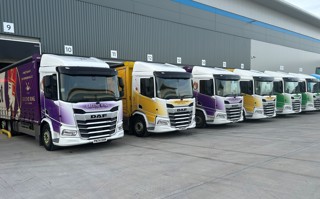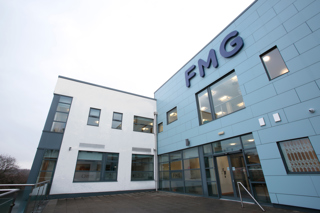This feature originally appeared in the April edition of Fleet News. Read the article in full
Two-and-half years ago Shaun Atton made what he considers his “best career move”. He switched from being a regional service manager at Auto Windscreens, looking after London and the east of the country, to becoming the business’s group fleet manager, responsible for 81 company cars and 360 vans.
Fleet was initially just a project – he was asked by the operations director to look at the fleet department from an operational point of view to streamline processes – but Atton says he “fell in love with it” and chose not to return to his regional manager’s role.
“Some people might see that as a backwards step or a sideways step but it’s not; it’s the best career move I’ve made so far,” Atton says. “I love it, it’s so fast-paced. Every week there is something different happening.”
Atton has worked for Auto Windscreens for 17 years, initially as an apprentice glass repair and replacement technician, progressing to fitting centre manager, area manager and then regional manager, before taking on the fleet. That career path has proved invaluable.
“Having the experience of the operations has really helped me in the role,” he says. “Although I knew very little about fleet I knew a lot about the operation and what the demands were on the road for our staff, that helps me in the decisions I make.”
Atton learnt about fleet by speaking to other fleet managers and suppliers and reading white papers, industry publications and “masses of information on the internet”.
“It was a steep learning curve just dealing with all the information and putting it into use,” he says.
He has now made sweeping changes to the fleet operation, including implementing a new work-related road risk programme, replacing spreadsheets with a bespoke fleet management system, changing fuel card provider, switching from pool cars to daily rental, changing leasing provider and moving from using independent garages for MOTs and tyres to a national supplier with fixed rates.
These changes saw Auto Windscreens claim the Fleet News Awards most improved fleet title this year.
On the environmental front, Auto Windscreens has become carbon-neutral thanks to carbon offsetting, while replacement cycles have been reduced from four to three years (cutting CO2 by 5.4%). In addition, the commercial fleet will all be Euro 6 by the end of this month and hybrid and electric vehicles are being introduced to the car fleet.
At the start of last year, Atton was also tasked with creating one fleet policy for all the businesses owned by Auto Windscreens’ parent company, the Markerstudy Group, (an additional 110 vehicles) and, as of October, he assumed responsibility for a five-strong facilities team, handling compliance and maintenance across 61 sites in the UK.
Since the coronavirus lockdown, all 61 fitting hubs have been temporarily closed and all back office operations have been set up to work from home across the Auto Windscreens business.
A mobile service is still being provided for customers who need it, with priority given to key workers such as the NHS, emergency services and critical sector fleets.
Auto Windscreens and the Marketstudy Group have also teamed up with Tunbridge Wells Borough Council to deliver essential food and medical supplies to around 1,000 vulnerable residents in the area (see Commercialfleet.org, April 8).
Automation
Atton has found the secret to juggling his fleet responsibilities is to automate where possible.
When he took on the fleet role there were three administrators dealing with “really mundane tasks”, each with their own spreadsheet.
Now they use Auto Windscreens’ core operating system, Field Service Manager (FSM), which has been adapted by IT to include a fleet management system.
FSM handles all elements of Auto Windscreens’ vehicle repairs and replacement work from jobs booking and parts ordering to technician work schedules and job completion. The system now holds lease schedule information, MOT expiry dates, service intervals and records, mileages and vehicle handover forms.
The system has allowed the fleet team to automate alerts to drivers and line managers when MOT and servicing is due and provides details of what to do next. Service and
maintenance can be planned around the technicians’ shift patterns.
Drivers use FSM on their tablets to perform vehicle checks and if an issue is highlighted it automatically creates an alert for the fleet team to act on.
The system also pulls in telematics data and is accessible to operations managers across the business.
Telematics works in conjunction with VisionTrack’s 3G connected camera solution.
“VisionTrack is part of our Markerstudy Group,” Atton says. “It partnered with Webfleet and we were the first fleet to have the integration so the telematics speaks to the camera. If we have an alert on the camera it pulls it into Webfleet and puts it all onto one dashboard. And Webfleet feeds into our fleet management system, we’ve managed to get an open API so everything is combined. Automation is my buzzword.”
Prior to introducing telematics, a trial was held with six technicians at Auto Windscreens’ Leicester fitting hub. This provided vital feedback and helped get driver buy-in. Atton also hosted forums and conference calls, and went to sites to explain why telematics was being introduced.
The system provides in-vehicle feedback, beeping when drivers brake or accelerate too harshly, for example.
“It flashes up on the display 20 seconds after an event to say what it beeped for so if you were harsh braking to get out of a sticky situation it gives you 20 seconds so it’s a minimal distraction,” Atton says.
Vans have also been fitted with Advanced Driver Assistance Systems (ADAS), including collision mitigation with pedestrian detection, lane departure warning, adaptive cruise control, speed sign recognition, auto high beam and driver impairment monitoring.
Atton has seen first-hand that the collision mitigation works thanks to camera footage.
Any serious incidents are investigated by the driver’s line manager.
“They will sit down with the driver and look at the video footage together,” Atton says. “It’s not just to see who was at fault, we have a duty of care to make sure the driver is okay and to see if anything can be done differently to avoid it next time.”
All drivers are risk-assessed annually and have their licence checked with Applied Driving Techniques (ADT). This is followed with targeted training. For instance, if a driver has six points on their licence for speeding they complete a speed awareness module on their tablet.
Drivers who are unfamiliar with a particular type of vehicle undergo on-the-road training with Auto Windscreens’ in-house regional training officers who have been trained by ADT to assess and train technicians.
The officers also train high risk drivers based on telematics data or number of incidents.
“Our in-house trainers visit our technicians at least once a year for their core job so it made sense to tie driver training in,” Atton says. “Initially, when we tell a driver they are going to have someone sat next to them the response is ‘I know how to drive’ but when you get the feedback afterwards they have picked up on things from it so it is having a positive impact.”
The top performing drivers are rewarded through Auto Windscreens talent recognition programme and last year received High Street vouchers and were recognised in the company’s newsletter.
As well as the in-house approach to training, Atton has brought accident management in-house utilising Zenith Marque, which is owned by Markerstudy.
Overall, the changes to risk management have resulted in a 30.9% decrease in incidents since 2017, the claims ratio has fallen from 91% in 2018 to 58% last year and incident costs have reduced by £50,277.
Atton has also taken measures to improve control of grey fleet drivers who now all undergo licence checks with ADT as well as providing insurance, maintenance and MOT records.
Grey fleet drivers have been given fuel cards which are linked to MileageCount, which automatically records, measures and manages mileage expenses.
Auto Windscreens switched from using a pump price fuel card to a fixed price one with BP after a mapping exercise showed that BP locations matched with Auto Windscreens’ sites.
The use of telematics, combined with fuel card data, has cut fuel costs by 5.4% – a £93,441 saving last year.
Technicians can use a card or the BPme app to pay. Atton says using the app rather than drivers paying at the kiosk reduces downtime and increases van security.
Other measures Atton has taken to reduce downtime include using the What3words app, which allows technicians to pinpoint their location to three square metres for breakdown providers and emergency services, and partnering with Fleet Tyre Network, a national company that finds the closest tyre and MOT supplier to Auto Windscreens’ drivers. The business holds stock of Auto Windscreens’ preferred tyre at its locations, reducing downtime. Prior to working with Fleet Tyre Network, Auto Windscreens had relationships with numerous independent suppliers with no uniform approach in place for drivers or ability to control costs. The new approach has reduced average tyre costs from £97 to £83.
Atton also analysed utilisation of Auto Windscreens’ eight pool cars across the country and found they were being used just over 50% of the week. They were an “administration headache” too as cars were returned with damage and needed cleaning, servicing and maintaining.
He decided to switch to daily rental with Arnold Clark, almost halving costs to £13,980 per annum compare to pool car costs of £26,292 per annum.
The majority of company cars and vans are leased through Arnold Clark, CVM and Rivervale with maintenance carried out in-house.
Atton reviewed manufacturers and decided to remain with Ford for commercial vehicles as the Custom best suited the business’s needs for load space for carrying its biggest windscreen and the vehicle is the right height for the canopies that technicians use for mobile work.
A place for everything
A new racking system has been introduced to meet demands for the latest tools and tooling technology and ensure health and safety compliance.
“We got a forum of technicians together,” Atton says. “We gave them two empty vans, two lots of van equipment and let them play around with it for two days and they came up with design so we got their buy-in. It was a small change but one that has gone down really well.
“The brief was ‘a place for everything’ so everything across the fleet now goes in the same place so it makes it easier for the area manager doing van checks.”
All new vans also now feature a charity logo as part of a new corporate social responsibility project (see panel).
The company car fleet has changed from an open choice, which was a “nightmare to manage”, to six brands: BMW, Ford, Mercedes-Benz, Škoda, Volkswagen and Volvo.
“We asked drivers ‘what do you feel would suit your role out of these 40 vehicles?’. And we based it on their feedback,” Atton says. “Drivers have a choice of SUVs, estates and hybrids and we will review it every six months and then annually to make sure we’re still meeting their requirements.
There are currently 11 hybrids on the car fleet and Atton is looking at fully electric vehicles with a view to the entire car fleet being fully electric in five years’ time.
The commercial fleet is more challenging as the vehicles do high mileages.
Auto Windscreens has a Citroën Berlingo which it trialled in London but “it didn’t work”.
“The claimed range was not what it was actually doing and when it was running the telematics, the camera, the heating etc. the mileage was much less than we needed,” Atton says.
“While it wasn’t doing tasks because it was charging, we were losing revenue.
“The day came when the driver rang me during the winter. He sent me a link for some thermal self-charging underwear. I said ‘what’s that?’ He said ‘I can plug it in overnight and it’s warm for me the next day’. I said ‘why do you need that?’. He said ‘Because I can’t have the heating on in the van because I’m not getting the range’ so we pulled it back.
“We still use it, our mechanic in head office uses it to do local journeys for repairs so it has got a benefit but not on that scale and that’s why I’m still not ready to put commercial vehicles out there yet.”
Rapid charging points are in place at 12 of Auto Windscreens’ sites, which are available for customer and staff use, and the business is reviewing which ‘hotspots’ to install further points.
Atton says the charging points and electrifying the car fleet sits alongside carbon offsetting. Auto Windscreens has worked with BP Target Neutral since 2018, buying carbon credits issued by projects across the globe that are making measurable carbon reductions such as the protection of Zambia’s forests. As a result it has gained carbon neutral certification in 2018 and 2019.
Staff are also encouraged to use BP’s online calculator to offset their own emissions generated by flights, driving and other journeys.
Atton acknowledges that there are critics of carbon offsetting schemes but it is a “hard feat” for a business of its size to be carbon neutral without offsetting and he points out that the business has introduced other environmentally-friendly measures.
At its head office in Chesterfield, managers are encouraged to make their company car available during the day for members of their team to use for business journeys.
“Sometimes it’s a difficult conversation to have because it’s their car, they’ve got their personal belongings in, but they appreciate it is saving their department from the cost of a rental car,” Atton says.
He is looking into whether managers with a company car in London might prefer a mobility allowance to use on public transport instead.
“We’re always looking at what is coming next and what can we do differently,” he says.
Atton on… Charities
Auto Windscreens has chosen to support local charities by featuring their logos on its engineers’ vans.
“We’ve got 20 areas and we’ve let the area managers and their group of technicians choose a charity for their area,” Shaun Atton says.
By the end of this year all vans will feature a logo.
“Some areas have chosen a charity with a particular story behind it,” Atton says. “For instance, the daughter of one our technicians has an incurable kidney disease so we are featuring the Kidney Care logo.”
Another area has chosen to promote Young Epilepsy as the five-year-old cousin of a supervisor, Ellie Ribbans (pictured below), suffers from severe epilepsy and the charity has provided vital support for her and her family (see Commercialfleet.org, February 28).
Atton says that the initiatives helps raise awareness of charities and staff are actively encouraged to fundraise for their chosen organisation.
Organisation: Auto Windscreens
- Group fleet manager: Shaun Atton
- Time in role: 30 months
- Fleet size: 441 – 81 cars, 360 vans
- Brands on fleet: cars – BMW, Ford, Mercedes-Benz, Škoda, Volkswagen and Volvo; vans – Ford.





















Login to comment
Comments
No comments have been made yet.